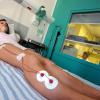A new study reveals the unique cell-to-cell communication networks that can perpetuate inflammation and prevent repigmentation in patients with vitiligo disease.

Professor of Dermatology Anand K Ganesan said: “In this study, we couple advanced imaging with transcriptomics and bioinformatics to discover the cell-to-cell communication networks between keratinocytes, immune cells and melanocytes that drive inflammation and prevent repigmentation caused by vitiligo.
“This discovery will enable us to determine why white patches continue to persist in stable vitiligo disease, which could lead to new therapeutics to treat this disease.”
Vitiligo is an autoimmune skin disease that is characterised by the progressive destruction of melanocytes, which are mature melanin-forming cells in the skin, by immune cells called autoreactive CD8+ T cells that result in disfiguring patches of white depigmented skin. This disease has been shown to cause significant psychological distress among patients.
Melanocyte destruction in active vitiligo is mediated by CD8+ T cells, but, until now, why the white patches in stable disease persist was poorly understood.
The authors identified distinct subpopulations of keratinocytes in lesional skin of stable vitiligo patients, along with the changes in cellular compositions in stable vitiligo skin that drive disease persistence.
In patients that responded to punch grafting treatment, these changes were reversed, highlighting their role in disease persistence.
The findings of this study raise the possibility of targeting keratinocyte metabolism in vitiligo treatment.
Further studies are needed to improve the understanding of how keratinocyte states affect the tissue microenvironment and contribute to disease pathogenesis.
Image credit | iStock



